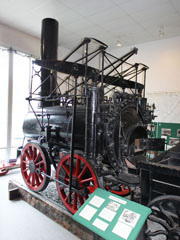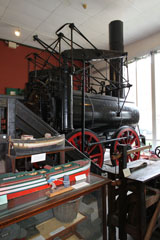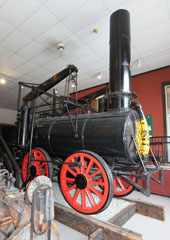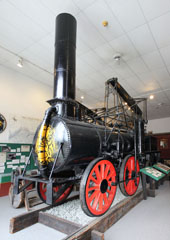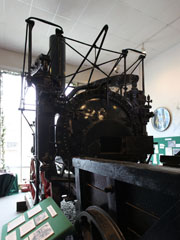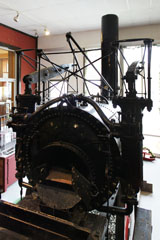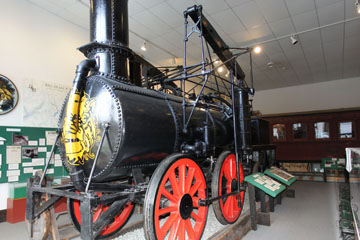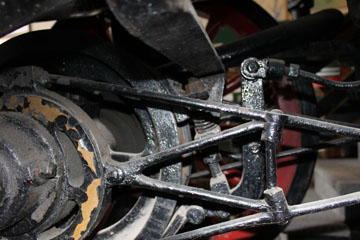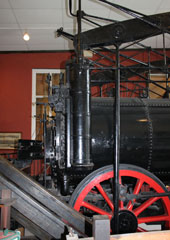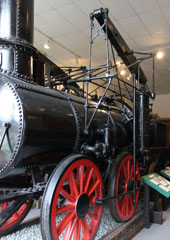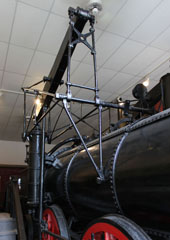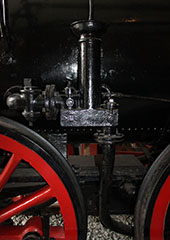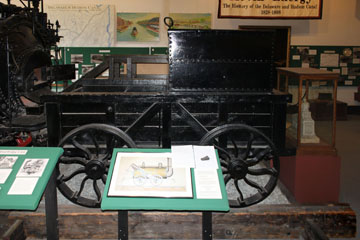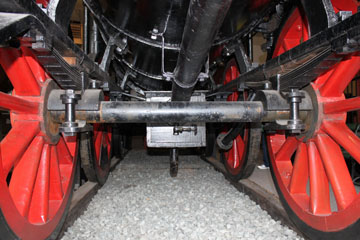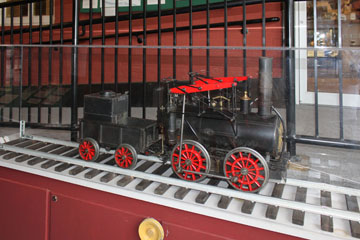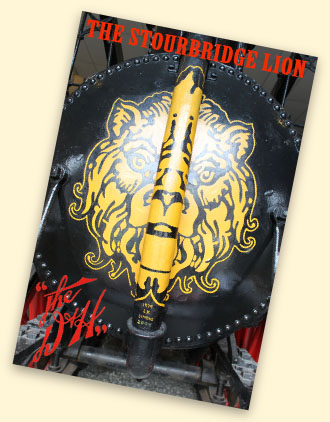

This replica of the “Stourbridge Lion” was built by the Delaware & Hudson Railroad in 1932 from plans and parts of the original, which was the first steam locomotive to operate in the US, and one of the first to operate outside Britain. Its name comes from the lion's face painted on the front, and the City of Stourbridge in England, where it was built by Foster, Rastrick & Company in 1828.
The company built only four steam locomotives. Three of them, the "Stourbridge Lion", the "Delaware" and the "Hudson" were ordered by Horatio Allen, a former co-worker of the Delaware & Hudson Canal Company’s Chief Engineer, John B. Jervis, while on a tour of the UK to investigate the new technology of steam locomotion.
Construction of the line started in 1826 and was completed in 1829.
The three Rastrick engines arrived in New York in May 1829. A fourth locomotive ordered from the Robert Stephenson Company named the “Pride of Newcastle” had already arrived a couple of months earlier, but it was the “Stourbridge Lion” that was first to operate. It was assembled at the West Point Foundry in New York where it was tested under steam in 1829 and then shipped out to Honesdale, PA. The “Lion’s” first official run took place there on 8th August that year.
The D&H Canal Company was chartered in 1823 to build and operate canals between New York City and the coal fields around Carbondale, PA.
However, company engineers began thinking about rail transportation as early as 1825, and an initial plan was to build a railroad between the mines and the western end of the canal as a way to get the coal to the canal boats. Jervis proposed a series of gravity inclines connected by level sections to get the anthracite from the Wurts' mine in the Moosic Mountains near Carbondale to the canal at Honesdale.
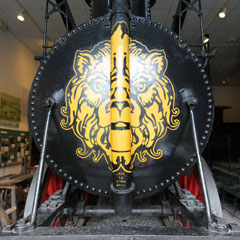
The "Lion" performed well, although the track on which it ran was too light for the work. Jervis had specified the three locomotives should weigh no more than 4 tons, but the “Lion” weighed 7½ tons.
A 4’ 3” gauge 0-4-0 coal burner with a wheelbase of 17’ 4”, the “Lion” had 48” drivers and
8½” x 36” cylinders. The piston rods connect to a pair of walking beams (one for each piston) mounted above the boiler. A connecting rod near the piston end of the walking beams drove the rear axle's wheels, which were connected to a coupling rod to drive the front wheels. The 4’ diameter boiler had a single flue, with the chimney exiting through the upper part of the boiler drum.
The “Lion” operated at a boiler pressure of 50 psi and delivered 1,750-2,000 lbs tractive effort.
With local locomotive manufacturers starting to produce improved designs as early as 1830, the four British engines were considered unsuitable and, by 1834, the D&H was trying to sell them to the Pennsylvania Canal Commission. However, the sale was never finalised and the locomotives were used as sources of English wrought-iron bar stock until the middle of the 1840s.
By 1845, all that was left of the “Lion” was its boiler, which was used in a foundry in Carbondale for about another five years until the foundry was sold a few years later.
The 1932 replica appeared at the 1933-34 Chicago World’s Fair, the 1939-40 New York World’s Fair and the Chicago Railroad Fair. It was subsequently loaned to Wayne County Historical Society where it remains to this day. The museum is located in a small brick building on Main Street, Honesdale, PA, which was once the D&H Canal's company office, and is where the Stourbridge Lion began its inaugural run.
You can see photos of what remains of the original “Stourbridge Lion” on the B&O Railroad Museum Roundhouse page of this website.
The new owners saw the boiler's value as a piece of history and reportedly tried selling it for $1,000 in 1874 but were unable to find a buyer.
In 1883, the D&H borrowed the boiler to display at the Exposition of Railway Appliances in Chicago. Unfortunately, security around the boiler's transportation was lax and souvenir hunters pulled every loose item that they could off the now historic boiler. The boiler went into storage again and was eventually acquired by the Smithsonian Institution in 1890. It is now on loan to the Baltimore & Ohio Railroad Museum.


